实验室用水的种类和区别
- 格式:docx
- 大小:23.54 KB
- 文档页数:5
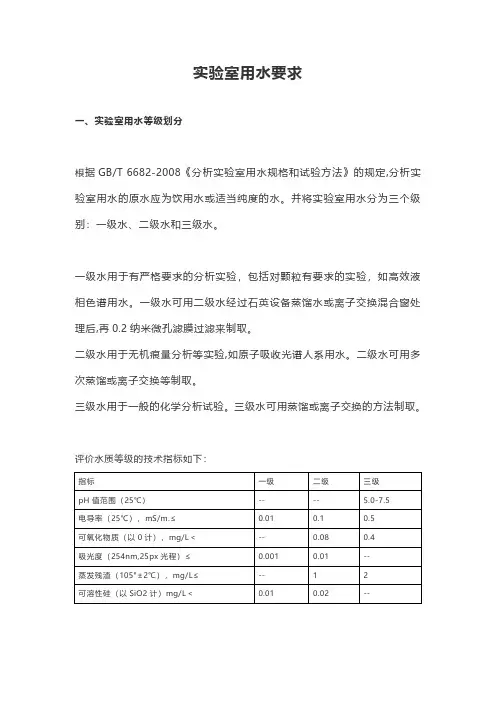
实验室用水要求
二、实验室常见用水的种类:
1、蒸馏水(Distilled Water)
实验室最常用的一种纯水,虽设备便宜,但极其耗能和费水且速度慢,应用会逐渐减少。
蒸馏水能去除自来水内大部分的污染物,但挥发性的杂质无法去除,如二氧化碳、氨、二氧化硅以及一些有机物。
新鲜的蒸馏水是无菌的,但储存后细菌易繁殖;此外,储存的容器也很讲究,若是非惰性的物质,离子和容器的塑形物质会析出造成二次污染。
2、去离子水(Deionized Water)
应用离子交换树脂去除水中的阴离子和阳离子,但水中仍然存在可溶性的有机物,可以污染离子交换柱从而降低其功效,去离子水存放后也容易引起细菌的繁殖。
3、反渗水(Reverse osmosis Water)
其生成的原理是水分子在压力的作用下,通过反渗透膜成为纯水,水中的杂质被反渗透膜截留排出。
反渗水克服了蒸馏水和去离子水的许多缺点,利用反渗透技术可以有效的去除水中的溶解盐、胶体,细菌、病毒、细菌内毒素和大部分有机物等杂质,但不同厂家生产的反渗透膜对反渗水的质量影响很大。
4、超纯水(Ultra-pure grade water)
转载只为分享知识,如有侵权请联系删除。
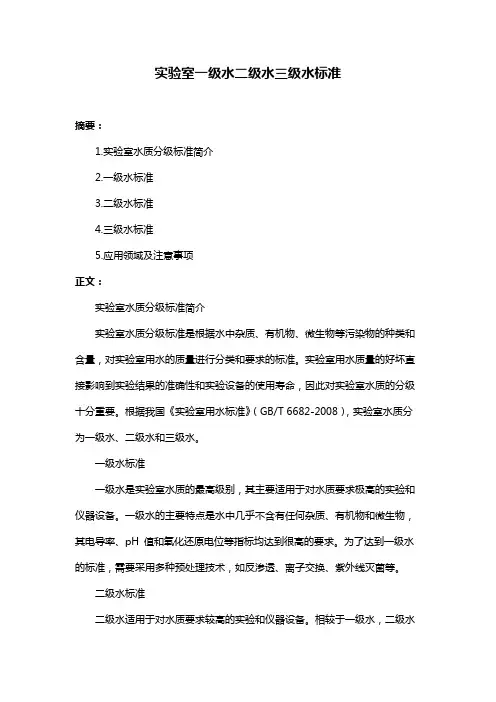
实验室一级水二级水三级水标准摘要:1.实验室水质分级标准简介2.一级水标准3.二级水标准4.三级水标准5.应用领域及注意事项正文:实验室水质分级标准简介实验室水质分级标准是根据水中杂质、有机物、微生物等污染物的种类和含量,对实验室用水的质量进行分类和要求的标准。
实验室用水质量的好坏直接影响到实验结果的准确性和实验设备的使用寿命,因此对实验室水质的分级十分重要。
根据我国《实验室用水标准》(GB/T 6682-2008),实验室水质分为一级水、二级水和三级水。
一级水标准一级水是实验室水质的最高级别,其主要适用于对水质要求极高的实验和仪器设备。
一级水的主要特点是水中几乎不含有任何杂质、有机物和微生物,其电导率、pH 值和氧化还原电位等指标均达到很高的要求。
为了达到一级水的标准,需要采用多种预处理技术,如反渗透、离子交换、紫外线灭菌等。
二级水标准二级水适用于对水质要求较高的实验和仪器设备。
相较于一级水,二级水的杂质、有机物和微生物含量有所增加,但其电导率、pH 值和氧化还原电位等指标仍然保持在较高水平。
为了达到二级水的标准,需要采用反渗透、离子交换等预处理技术,并进行适当的后续处理。
三级水标准三级水适用于对水质要求一般的实验和仪器设备。
其主要特点是水中杂质、有机物和微生物含量较高,电导率、pH 值和氧化还原电位等指标相对较低。
为了达到三级水的标准,需要采用适当的预处理技术,如砂滤、活性炭吸附等。
应用领域及注意事项实验室水质分级标准在各个领域都有广泛的应用,包括化学、生物、医学、环境等。
在选择实验室用水时,应根据实验的准确性要求、实验设备的敏感性以及实验方法的特殊性等因素,选择适当的水质级别。
在使用过程中,还需要注意定期检测水质,确保实验用水质量的稳定性。

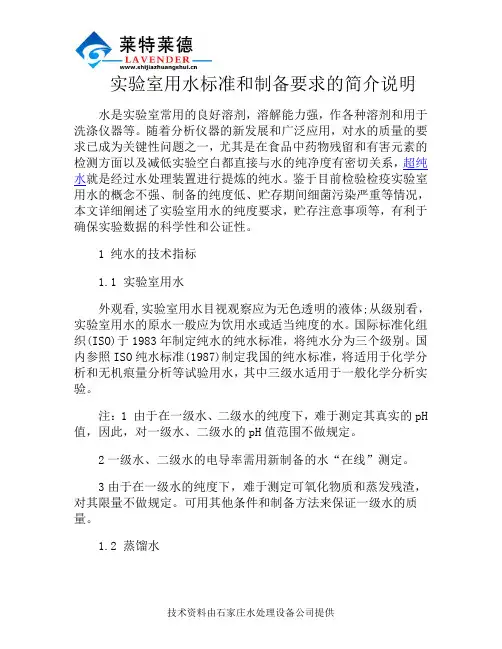
实验室用水标准和制备要求的简介说明水是实验室常用的良好溶剂,溶解能力强,作各种溶剂和用于洗涤仪器等。
随着分析仪器的新发展和广泛应用,对水的质量的要求已成为关键性问题之一,尤其是在食品中药物残留和有害元素的检测方面以及减低实验空白都直接与水的纯净度有密切关系,超纯水就是经过水处理装置进行提炼的纯水。
鉴于目前检验检疫实验室用水的概念不强、制备的纯度低、贮存期间细菌污染严重等情况,本文详细阐述了实验室用水的纯度要求,贮存注意事项等,有利于确保实验数据的科学性和公证性。
1 纯水的技术指标1.1 实验室用水外观看,实验室用水目视观察应为无色透明的液体;从级别看,实验室用水的原水一般应为饮用水或适当纯度的水。
国际标准化组织(ISO)于1983年制定纯水的纯水标准,将纯水分为三个级别。
国内参照ISO纯水标准(1987)制定我国的纯水标准,将适用于化学分析和无机痕量分析等试验用水,其中三级水适用于一般化学分析实验。
注:1 由于在一级水、二级水的纯度下,难于测定其真实的pH 值,因此,对一级水、二级水的pH值范围不做规定。
2一级水、二级水的电导率需用新制备的水“在线”测定。
3由于在一级水的纯度下,难于测定可氧化物质和蒸发残渣,对其限量不做规定。
可用其他条件和制备方法来保证一级水的质量。
1.2 蒸馏水蒸馏水系指《中华人民共和国药典》(1995年版)所收载的蒸馏水,在该版的凡例二十五条中明确指出,试验用的水,除令有规定外,均系指蒸馏水或去离子水。
由上所知,一般实验室用水不外乎三级水和蒸馏水这两种规格,但计量认证时则要求实验室用水必需按GB6682-92执行。
可以看出,三级水与蒸馏水在外观、性状方面基本相同,控制的成分是一致的。
只是药典中所载的蒸馏水其检验项目较GB6682-92中三级水的项目多而全,这可能是因为蒸馏水除做实验用水外,还因药用的缘故。
1.3 去离子水用离子交换法制得的化验用水,常称去离子水或离子交换水。
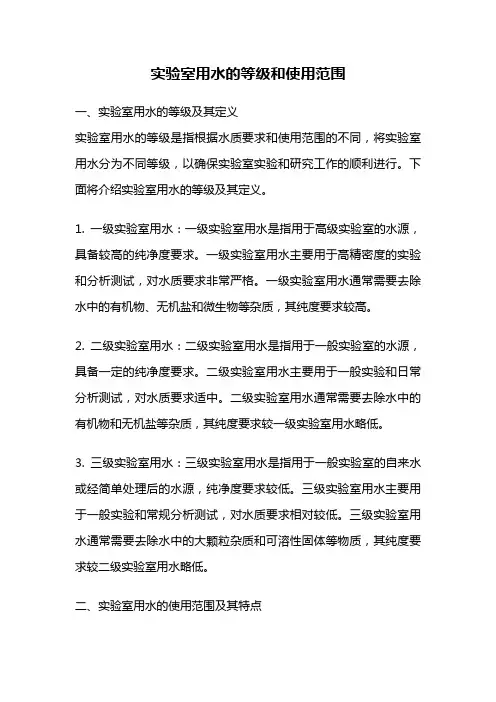
实验室用水的等级和使用范围一、实验室用水的等级及其定义实验室用水的等级是指根据水质要求和使用范围的不同,将实验室用水分为不同等级,以确保实验室实验和研究工作的顺利进行。
下面将介绍实验室用水的等级及其定义。
1. 一级实验室用水:一级实验室用水是指用于高级实验室的水源,具备较高的纯净度要求。
一级实验室用水主要用于高精密度的实验和分析测试,对水质要求非常严格。
一级实验室用水通常需要去除水中的有机物、无机盐和微生物等杂质,其纯度要求较高。
2. 二级实验室用水:二级实验室用水是指用于一般实验室的水源,具备一定的纯净度要求。
二级实验室用水主要用于一般实验和日常分析测试,对水质要求适中。
二级实验室用水通常需要去除水中的有机物和无机盐等杂质,其纯度要求较一级实验室用水略低。
3. 三级实验室用水:三级实验室用水是指用于一般实验室的自来水或经简单处理后的水源,纯净度要求较低。
三级实验室用水主要用于一般实验和常规分析测试,对水质要求相对较低。
三级实验室用水通常需要去除水中的大颗粒杂质和可溶性固体等物质,其纯度要求较二级实验室用水略低。
二、实验室用水的使用范围及其特点实验室用水的使用范围根据实验和研究的需要,可以分为不同的用途。
下面将介绍实验室用水的使用范围及其特点。
1. 实验室用水的常规用途:实验室用水的常规用途包括实验设备清洗、试剂配置、实验容器清洗等。
这些用途对水质要求相对较低,一般使用三级实验室用水即可满足需求。
2. 实验室用水的实验分析用途:实验室用水在实验分析过程中起到重要作用,如用于样品稀释、溶解试剂、洗涤实验仪器等。
这些用途对水质要求较高,一般需要使用二级实验室用水。
3. 实验室用水的仪器设备用途:实验室中的一些仪器设备,如离心机、超净台等,需要使用纯净水源,以确保实验结果的准确性和可靠性。
这些用途对水质要求非常严格,一般需要使用一级实验室用水。
4. 实验室用水的生物实验用途:实验室中进行生物实验时,需要使用无菌水源,以防止微生物对实验结果的影响。
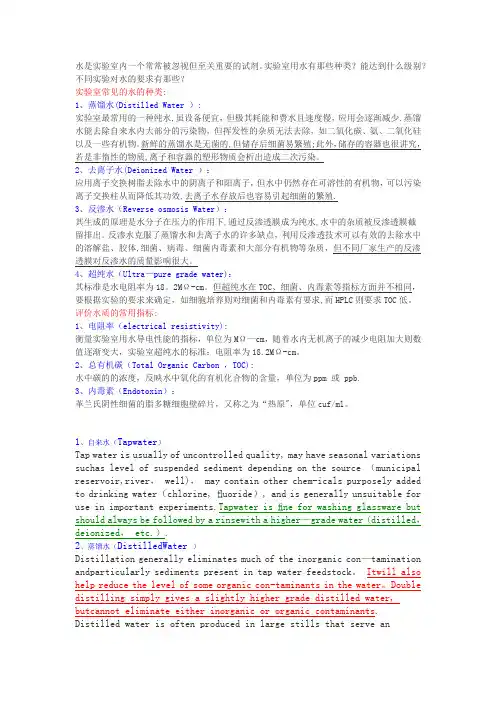
水是实验室内一个常常被忽视但至关重要的试剂。
实验室用水有那些种类?能达到什么级别?不同实验对水的要求有那些?实验室常见的水的种类:1、蒸馏水(Distilled Water ):实验室最常用的一种纯水,虽设备便宜,但极其耗能和费水且速度慢,应用会逐渐减少.蒸馏水能去除自来水内大部分的污染物,但挥发性的杂质无法去除,如二氧化碳、氨、二氧化硅以及一些有机物。
新鲜的蒸馏水是无菌的,但储存后细菌易繁殖;此外,储存的容器也很讲究,若是非惰性的物质,离子和容器的塑形物质会析出造成二次污染。
2、去离子水(Deionized Water ):应用离子交换树脂去除水中的阴离子和阳离子,但水中仍然存在可溶性的有机物,可以污染离子交换柱从而降低其功效,去离子水存放后也容易引起细菌的繁殖.3、反渗水(Reverse osmosis Water):其生成的原理是水分子在压力的作用下,通过反渗透膜成为纯水,水中的杂质被反渗透膜截留排出。
反渗水克服了蒸馏水和去离子水的许多缺点,利用反渗透技术可以有效的去除水中的溶解盐、胶体,细菌、病毒、细菌内毒素和大部分有机物等杂质,但不同厂家生产的反渗透膜对反渗水的质量影响很大。
4、超纯水(Ultra—pure grade water):其标准是水电阻率为18。
2MΩ-cm。
但超纯水在TOC、细菌、内毒素等指标方面并不相同,要根据实验的要求来确定,如细胞培养则对细菌和内毒素有要求,而HPLC则要求TOC低。
评价水质的常用指标:1、电阻率(electrical resistivity):衡量实验室用水导电性能的指标,单位为MΩ—cm,随着水内无机离子的减少电阻加大则数值逐渐变大,实验室超纯水的标准:电阻率为18.2MΩ-cm。
2、总有机碳(Total Organic Carbon ,TOC):水中碳的的浓度,反映水中氧化的有机化合物的含量,单位为ppm 或 ppb.3、内毒素(Endotoxin):革兰氏阴性细菌的脂多糖细胞壁碎片,又称之为“热原",单位cuf/ml。
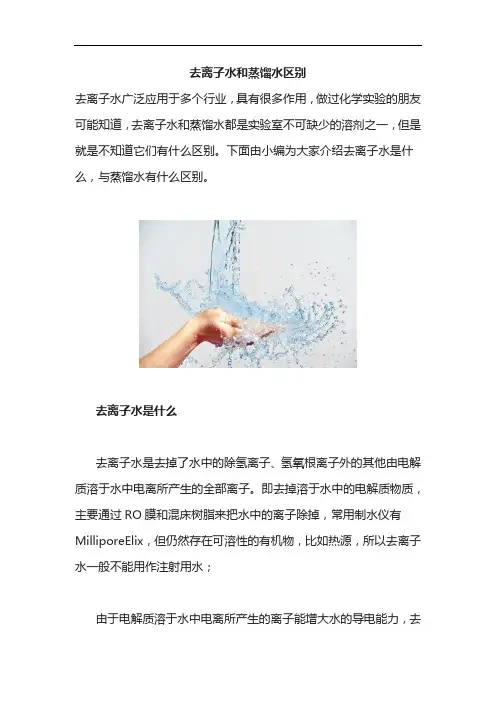
去离子水和蒸馏水区别去离子水广泛应用于多个行业,具有很多作用,做过化学实验的朋友可能知道,去离子水和蒸馏水都是实验室不可缺少的溶剂之一,但是就是不知道它们有什么区别。
下面由小编为大家介绍去离子水是什么,与蒸馏水有什么区别。
去离子水是什么去离子水是去掉了水中的除氢离子、氢氧根离子外的其他由电解质溶于水中电离所产生的全部离子。
即去掉溶于水中的电解质物质,主要通过RO膜和混床树脂来把水中的离子除掉,常用制水仪有MilliporeElix,但仍然存在可溶性的有机物,比如热源,所以去离子水一般不能用作注射用水;由于电解质溶于水中电离所产生的离子能增大水的导电能力,去离子水纯度自然用电导率来衡量。
去离子水基本用离子交换法制得。
但去离子水中可以含有不能电离的非电解质,如乙醇等。
去离子水和蒸馏水的区别通俗的说,去离子水和蒸馏水是两类水,而不是两种水。
普遍来说蒸馏水的离子比去离子水高,去离子去过不经过紫外消毒或者滤膜的话,可能会带点微生物,看具体工艺。
这两种针对的要求不同可以改,看你具体要求了。
比如药厂生产的话,就要用到纯化水和注射用水,芯片厂用18兆欧水之类的。
去离子水是用离子交换树脂来去除水中的大量的阴阳离子,但是不能去除所有的离子。
而蒸馏水,是蒸汽遇冷凝结的,所以基本不含离子(氢离子和氢氧根离子除外),所以蒸馏水的纯度要比去离子水的高,你测电导率就可以知道蒸馏水的电导率要低。
一般分析的时候使用蒸馏水,而工厂生产是使用去离子水。
这两种水的其他不同都是由制备方法不同所导致所以归根结底就是制备方法不同。
各方法做出来的水的纯度都会随着重复次数的增加而提高。
纯化任务要考虑的是原混合物的具体情况,选择有针对性的纯化方法。
所以,要比较的话,必须指明从什么水开始,经过几次蒸馏或几级渗透膜。
而且膜也有很多种类。
膜分离技术本身也在不断发展中。
用不同的膜除的是不同的东西,会为了除很冷门的物质而开发很冷门的膜。
细菌就可以通过过膜而除去,并不一定非要紫外。
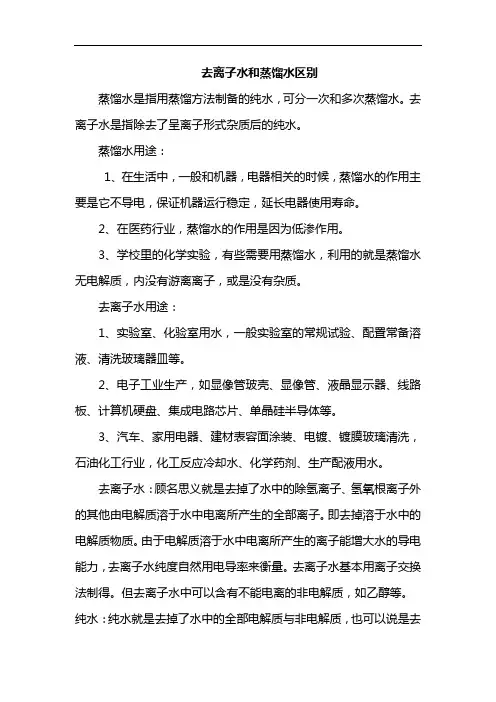
去离子水和蒸馏水区别蒸馏水是指用蒸馏方法制备的纯水,可分一次和多次蒸馏水。
去离子水是指除去了呈离子形式杂质后的纯水。
蒸馏水用途:1、在生活中,一般和机器,电器相关的时候,蒸馏水的作用主要是它不导电,保证机器运行稳定,延长电器使用寿命。
2、在医药行业,蒸馏水的作用是因为低渗作用。
3、学校里的化学实验,有些需要用蒸馏水,利用的就是蒸馏水无电解质,内没有游离离子,或是没有杂质。
去离子水用途:1、实验室、化验室用水,一般实验室的常规试验、配置常备溶液、清洗玻璃器皿等。
2、电子工业生产,如显像管玻壳、显像管、液晶显示器、线路板、计算机硬盘、集成电路芯片、单晶硅半导体等。
3、汽车、家用电器、建材表容面涂装、电镀、镀膜玻璃清洗,石油化工行业,化工反应冷却水、化学药剂、生产配液用水。
去离子水:顾名思义就是去掉了水中的除氢离子、氢氧根离子外的其他由电解质溶于水中电离所产生的全部离子。
即去掉溶于水中的电解质物质。
由于电解质溶于水中电离所产生的离子能增大水的导电能力,去离子水纯度自然用电导率来衡量。
去离子水基本用离子交换法制得。
但去离子水中可以含有不能电离的非电解质,如乙醇等。
纯水:纯水就是去掉了水中的全部电解质与非电解质,也可以说是去掉了水中的全部非水物质。
基本都用反渗透法制得。
由于在反渗透预处理中绝大多数都先用活性碳去除了部分非电解质,并且电导率非常容易测量,所以纯水纯度往往也用电导率衡量。
但如果要获得极高纯度的高纯水,还是需通过去除电解质的混床、EDI方法。
蒸馏水:以去除电解质及与水沸点相差较大的非电解质为主,无法去除与水沸点相当的非电解质,纯度也用电导率衡量。
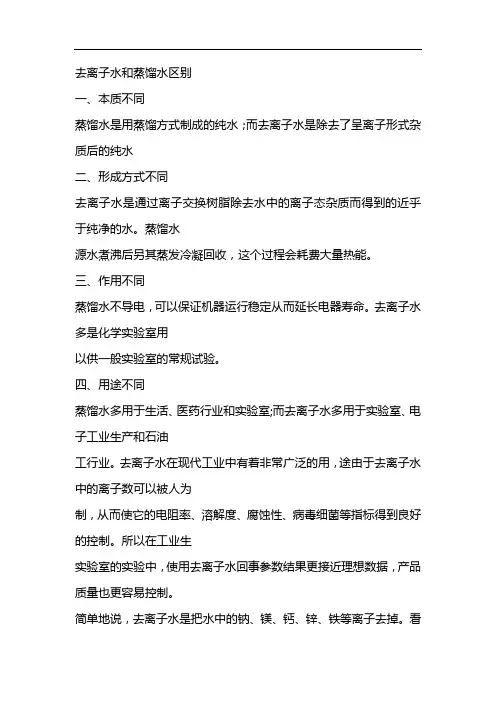
去离子水和蒸馏水区别
一、本质不同
蒸馏水是用蒸馏方式制成的纯水;而去离子水是除去了呈离子形式杂质后的纯水
二、形成方式不同
去离子水是通过离子交换树脂除去水中的离子态杂质而得到的近乎于纯净的水。
蒸馏水
源水煮沸后另其蒸发冷凝回收,这个过程会耗费大量热能。
三、作用不同
蒸馏水不导电,可以保证机器运行稳定从而延长电器寿命。
去离子水多是化学实验室用
以供一般实验室的常规试验。
四、用途不同
蒸馏水多用于生活、医药行业和实验室;而去离子水多用于实验室、电子工业生产和石油
工行业。
去离子水在现代工业中有着非常广泛的用,途由于去离子水中的离子数可以被人为
制,从而使它的电阻率、溶解度、腐蚀性、病毒细菌等指标得到良好的控制。
所以在工业生
实验室的实验中,使用去离子水回事参数结果更接近理想数据,产品质量也更容易控制。
简单地说,去离子水是把水中的钠、镁、钙、锌、铁等离子去掉。
看
看矿泉水的包装,肯定能看到这些离子的含量。
把这些离子除去,对做研究来说,实验结果就精确科学得多。
对日常生活来说,水由“硬水”变成“软水”,洗衣服的时候不起泡沫的问题得到解决,而且烧水的水壶也不会结垢,据说患结石的概率也会减少。
在家庭里,往往是通过直饮水的离子柱产生离子水。
一般都有一根柱子来出去细菌。
蒸馏水是要把水煮沸,水蒸气在锅盖受冷变回水滴,把这些水滴收集起来就是蒸馏水了。
蒸馏水中不排除有易挥发的物质以及和水共沸的物质,如酒精。
如前两位所言,有多级蒸馏的生产工艺保证水有足够的纯度。
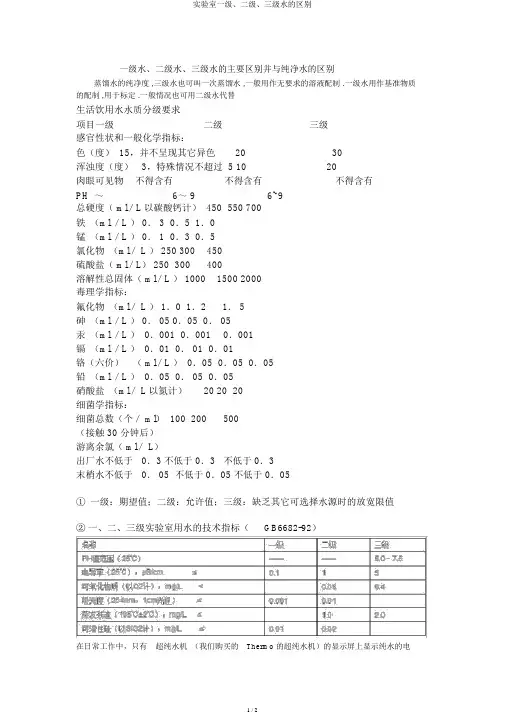
一级水、二级水、三级水的主要区别并与纯净水的区别蒸馏水的纯净度 ,三级水也可叫一次蒸馏水 ,一般用作无要求的溶液配制 .一级水用作基准物质的配制 ,用于标定 .一般情况也可用二级水代替生活饮用水水质分级要求项目一级二级三级感官性状和一般化学指标:色(度) 15,并不呈现其它异色2030浑浊度(度)3,特殊情况不超过 5 1020肉眼可见物不得含有不得含有不得含有PH ~6~ 96~9总硬度( ml/L 以碳酸钙计) 450 550 700铁(ml /L ) 0. 3 0.5 1.0锰(ml /L ) 0. 1 0.3 0.5氯化物(ml/ L ) 250 300450硫酸盐( ml/L) 250 300400溶解性总固体( ml/L ) 10001500 2000毒理学指标:氟化物(ml/ L ) 1.0 1.21. 5砷(ml /L ) 0. 05 0.05 0. 05汞(ml /L ) 0.001 0.0010.001镉(ml /L ) 0.01 0. 01 0.01铬(六价)( ml/L ) 0.05 0.05 0.05铅(ml /L ) 0.05 0. 05 0.05硝酸盐(ml/ L 以氮计)2020 20细菌学指标:细菌总数(个/ ml) 100 200500(接触 30 分钟后)游离余氯( ml/ L)出厂水不低于0.3 不低于 0.3不低于 0.3末梢水不低于0. 05 不低于 0.05 不低于 0.05① 一级:期望值;二级:允许值;三级:缺乏其它可选择水源时的放宽限值②一、二、三级实验室用水的技术指标(GB6682-92)在日常工作中,只有超纯水机(我们购买的Thermo 的超纯水机)的显示屏上显示纯水的电阻率为Ω*cm,没有其他参数;而在GB/T 6682 中要求的纯水检验项目有:1、电导率 <m ,这个换算成电阻率应该是10MΩ *cm2、可溶性硅 <L纯水与超纯水的区别电导率不同,纯水电导率在2-10us/cm 之间,超纯水的电导率为cm; B 、制造的难易程度不同,目前市场上使用的纯水基本上都是经过反渗透、蒸馏等方法制得,而超纯水是在纯水的基础上还要经过光氧化技术、精处理和抛光处理等一系列复杂的纯化技术制得的。
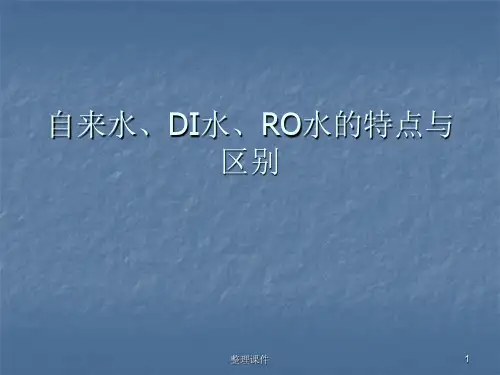
实验室蒸馏水、去离子水、高纯水、超纯水的区别一、天然水中通常含有五种杂质:1、电解质,包括带电粒子,常见的阳离子有H+、Na+、K+、NH4+、Mg2+、Ca2+、Fe3+、Cu2+、Mn2+、Al3+等;阴离子有F-、Cl-、NO3-、HCO3-、SO42-、PO43-、H2PO4-、HSiO3-等。
2、有机物质,如:有机酸、农药、烃类、醇类和酯类等。
3、颗粒物。
4、微生物。
5、溶解气体,包括:N2、O2、Cl2、H2S、CO、CO2、CH4等。
所谓水的纯化,就是要去掉这些杂质。
杂质去的越彻底,水质也就越纯净。
二、而实验室常用的蒸馏水、去离子水、高纯水、超纯水等,则是根据对这5种杂质的去除程度区分的:1、蒸馏水蒸馏水就是将水蒸馏、冷凝的水,蒸二次的叫重蒸水,三次的叫三蒸水。
有时候为了特殊目的,在蒸前会加入适当试剂,如为了无氨水,会在水中加酸;低耗氧量的水,加入高锰酸钾与酸等。
工业蒸馏水是采用蒸馏水方法取得的纯水,一般普通蒸馏取得的水纯度不高,经过多级蒸馏水,出水才可达到很纯,成本相对比较高。
2、去离子水去离子水就是将水通过阳离子交换树脂(常用的为苯乙烯型强酸性阳离子交换树脂),则水中的阳离子被树脂所吸收,树脂上的阳离子H+被置换到水中,并和水中的阳离子组成相应的无机酸;含此种无机酸的水再通过阴离子交换树脂(常用的为苯乙烯型强碱性阴离子)OH-被置换到水中,并和水中的H+结合成水,此即去离子水。
由于去离子水中的离子数可以被人为的控制,从而,使它的电阻率、溶解度、腐蚀性、病毒细菌等物理、化学及病理等指标均得到良好的控制。
在工业生产及实验室的实验中,如果涉及到使用水的工艺都被使用了去离子水,那么,许多参数会更接近设计或理想数据,产品质量将变得易于控制。
三、高纯水是指化学纯度极高的水,其主要应用在生物、化学化工、冶金、宇航、电力等领域,但其对水质纯度要求相当高,所以一般应用最普遍的还是电子工业。
例如电力系统所用的纯水,要求各杂质含量低达到“微克/升”级。
中国国家实验室用水规格中国国家实验室用水规格是指国家对实验室在使用水资源方面的要求和规定,旨在合理利用水资源,提高实验室工作效率和生态环境保护水平。
以下是相关参考内容:1. 实验室用水种类分类:根据水质要求和用途不同,实验室用水可以分为纯水、超纯水、一般水和工艺水等多种类型。
纯水主要用于一般实验室操作、仪器设备清洗和一般实验需求;超纯水则适用于高灵敏度实验和特殊要求实验操作;一般水一般用于设备的换热、冷却和其他一般用途;工艺水则用于实验室建设、消防、卫生等综合用途。
2. 实验室用水质要求:实验室用水的质量要求依据具体实验的需要而有所不同。
一般而言,纯水要求总溶解固体浓度低于10mg/L、电导率低于5μs/cm、细菌总数低于100CFU/mL;超纯水则要求电导率低于0.1μs/cm、细菌总数低于10CFU/mL;一般水质要求电导率低于300μs/cm、细菌总数低于1000CFU/mL。
3. 实验室用水消耗量控制:为了合理利用水资源,实验室应该根据实验需要,制定合理的用水计划,并进行水资源的监控与管理。
通过采用节水设施,如喷头、自动关闭阀等,以及加强员工节水意识培养,限制长时间不必要的水流使用,减少水资源消耗。
4. 实验室用水设备优化:采用高效的水处理设备是确保实验室用水质量的重要保障。
实验室需要根据需要选择合适的纯化设备,如反渗透设备、离子交换设备和电离交换设备等,确保实验用水符合质量要求。
5. 水资源回收再利用:实验室可以采用水资源回收再利用技术,将实验废水进行分解、净化和再利用。
通过这种方式,可以降低对自来水消耗,节约水资源,同时也减少了废水排放对环境的影响。
6. 实验室用水安全和卫生要求:为确保实验室用水的安全和卫生,实验室应建立健全的水质监测体系,定期对实验室用水进行监测和检测,及时发现和解决水质问题。
此外,实验室应制定相应的水质管理制度和防护措施,保障实验人员的身体健康。
7. 实验室用水管理监督:实验室用水管理监督主要由相关部门进行。
实验室用水标准
实验室是科研和教学的重要场所,而实验室用水的质量和标准则直接关系到实验室工作的顺利进行和实验结果的准确性。
因此,制定实验室用水标准是非常重要的。
实验室用水标准主要包括水质标准、水源标准、水质监测和管理标准等内容。
首先,实验室用水的水质标准是非常重要的。
实验室用水应符合国家相关标准和规定,水质应清澈透明,无色无味,不含有害物质,微生物指标符合卫生标准。
在实验室工作中,水质的好坏直接关系到实验结果的准确性,因此实验室用水的水质标准必须严格执行。
其次,实验室用水的水源标准也是非常重要的。
实验室用水的水源应当来自正规的水厂或者经过严格处理的自来水,不得使用未经处理的地下水或者水质不合格的水源。
水源的选择直接关系到实验室用水的质量,因此必须严格按照水源标准进行选择和管理。
另外,实验室用水的水质监测和管理标准也是必不可少的。
实验室应当建立水质监测系统,定期对实验室用水进行水质检测,确保水质符合标准要求。
同时,实验室应当建立健全的用水管理制度,对实验室用水进行严格管理,确保用水的安全和质量。
总之,实验室用水标准是非常重要的,对于实验室工作的顺利进行和实验结果的准确性有着直接的影响。
因此,实验室用水标准必须严格执行,确保实验室用水的质量和安全。
希望各个实验室能够重视实验室用水标准,加强对实验室用水的管理和监测,确保实验室用水的质量符合标准要求,为科研和教学提供良好的保障。
水是实验室内一个常常被忽视但至关重要的试剂。
实验室用水有那些种类能达到什么级别不同实验对水的要求有那些实验室常见的水的种类:1、蒸馏水(Distilled Water ):实验室最常用的一种纯水,虽设备便宜,但极其耗能和费水且速度慢,应用会逐渐减少。
蒸馏水能去除自来水内大部分的污染物,但挥发性的杂质无法去除,如二氧化碳、氨、二氧化硅以及一些有机物。
新鲜的蒸馏水是无菌的,但储存后细菌易繁殖;此外,储存的容器也很讲究,若是非惰性的物质,离子和容器的塑形物质会析出造成二次污染。
2、去离子水(Deionized Water ):应用离子交换树脂去除水中的阴离子和阳离子,但水中仍然存在可溶性的有机物,可以污染离子交换柱从而降低其功效,去离子水存放后也容易引起细菌的繁殖。
3、反渗水(Reverse osmosis Water):其生成的原理是水分子在压力的作用下,通过反渗透膜成为纯水,水中的杂质被反渗透膜截留排出。
反渗水克服了蒸馏水和去离子水的许多缺点,利用反渗透技术可以有效的去除水中的溶解盐、胶体,细菌、病毒、细菌内毒素和大部分有机物等杂质,但不同厂家生产的反渗透膜对反渗水的质量影响很大。
4、超纯水(Ultra-pure grade water):其标准是水电阻率为Ω-cm。
但超纯水在TOC、细菌、内毒素等指标方面并不相同,要根据实验的要求来确定,如细胞培养则对细菌和内毒素有要求,而HPLC则要求TOC低。
评价水质的常用指标:1、电阻率(electrical resistivity):衡量实验室用水导电性能的指标,单位为MΩ-cm,随着水内无机离子的减少电阻加大则数值逐渐变大,实验室超纯水的标准:电阻率为Ω-cm。
2、总有机碳(Total Organic Carbon ,TOC):水中碳的的浓度,反映水中氧化的有机化合物的含量,单位为ppm 或ppb。
3、内毒素(Endotoxin):革兰氏阴性细菌的脂多糖细胞壁碎片,又称之为“热原”,单位cuf/ml。
去离子水和蒸馏水的区别1、蒸馏水:就是将水蒸馏、冷凝的水,蒸二次的叫重蒸水,三次的叫三蒸水。
有时候为了特殊目的,在蒸前会加入适当试剂,如为了无氨水,会在水中加酸;低耗氧量的水,加入高锰酸钾与酸等。
工业蒸馏水是采用蒸馏水方法取得的纯水,一般普通蒸馏取得的水纯度不高,经过多级蒸馏水,出水才可达到很纯,成本相对比较高。
2、去离子水就是将水通过阳离子交换树脂常用的为苯乙烯型强酸性阳离子交换树脂,则水中的阳离子被树脂所吸收,树脂上的阳离子H+被置换到水中,并和水中的阳离子组成相应的无机酸;含此种无机酸的水再通过阴离子交换树脂常用的为苯乙烯型强碱性阴离子OH-被置换到水中,并和水中的H+结合成水,此即去离子水。
去离子水在现代工业中有着非常广泛的用途,使用去离子水,是我国很多行业提高产品质量的,赶超世界先进水平的重要手段之一。
由于去离子水中的离子数可以被人为的控制,从而,使它的电阻率、溶解度、腐蚀性、病毒细菌等物理、化学及病理等指标均得到良好的控制。
在工业生产及实验室的实验中,如果涉及到使用水的工艺都被使用了去离子水,那么,许多参数会更接近设计或理想数据,产品质量将变得易于控制。
1、离子交换树脂制取去离子水的传统水处理方式,其基本工艺流程为:原水→多介质过滤器→活性炭过滤器→精密过滤器→阳床→阴床→混床→后置保安过滤器→用水点。
特点:污染比较大,自动化程度低,初期投入低2、反渗透水处理设备与离子交换设备进行组合制取去离子水的方式,其基本工艺流程为:原水→多介质过滤器→活性炭过滤器→精密过滤器→反渗透设备→混床→超纯水箱→超纯水泵→后置保安过滤器→用水点。
特点:污染小,自动化程度高,初期投入中等,价格适中3、反渗透设备与电去离子EDI设备进行搭配制取去离子水的的方式,这是一种制取超纯水的最新工艺,也是一种环保,经济,发展潜力巨大的超纯水制备工艺,其基本工艺流程为:原水→多介质过滤器→活性炭过滤器→精密过滤器→反渗透设备→电去离子EDI→超纯水箱→超纯水泵→后置保安过滤器→用水点。
实验室用水的种类和区别Company Document number:WTUT-WT88Y-W8BBGB-BWYTT-19998水是实验室内一个常常被忽视但至关重要的试剂。
实验室用水有那些种类能达到什么级别不同实验对水的要求有那些?实验室常见的水的种类:1、蒸馏水(Distilled Water ):实验室最常用的一种纯水,虽设备便宜,但极其耗能和费水且速度慢,应用会逐渐减少。
蒸馏水能去除自来水内大部分的污染物,但挥发性的杂质无法去除,如二氧化碳、氨、二氧化硅以及一些有机物。
新鲜的蒸馏水是无菌的,但储存后细菌易繁殖;此外,储存的容器也很讲究,若是非惰性的物质,离子和容器的塑形物质会析出造成二次污染。
2、去离子水(Deionized Water ):应用离子交换树脂去除水中的阴离子和阳离子,但水中仍然存在可溶性的有机物,可以污染离子交换柱从而降低其功效,去离子水存放后也容易引起细菌的繁殖。
3、反渗水(Reverse osmosis Water):其生成的原理是水分子在压力的作用下,通过反渗透膜成为纯水,水中的杂质被反渗透膜截留排出。
反渗水克服了蒸馏水和去离子水的许多缺点,利用反渗透技术可以有效的去除水中的溶解盐、胶体,细菌、病毒、细菌内毒素和大部分有机物等杂质,但不同厂家生产的反渗透膜对反渗水的质量影响很大。
4、超纯水(Ultra-pure grade water):其标准是水电阻率为Ω-cm。
但超纯水在TOC、细菌、内毒素等指标方面并不相同,要根据实验的要求来确定,如细胞培养则对细菌和内毒素有要求,而HPLC则要求TOC低。
评价水质的常用指标:1、电阻率(electrical resistivity):衡量实验室用水导电性能的指标,单位为MΩ-cm,随着水内无机离子的减少电阻加大则数值逐渐变大,实验室超纯水的标准:电阻率为Ω-cm。
2、总有机碳(Total Organic Carbon ,TOC):水中碳的的浓度,反映水中氧化的有机化合物的含量,单位为ppm 或 ppb。
水是实验室内一个常常被忽视但至关重要的试剂。
实验室用水有那些种类?能达到什么级别?不同实验对水的要求有那些?实验室常见的水的种类:1、蒸馏水(Distilled Water ):实验室最常用的一种纯水,虽设备便宜,但极其耗能和费水且速度慢,应用会逐渐减少。
蒸馏水能去除自来水内大部分的污染物,但挥发性的杂质无法去除,如二氧化碳、氨、二氧化硅以及一些有机物。
新鲜的蒸馏水是无菌的,但储存后细菌易繁殖;此外,储存的容器也很讲究,若是非惰性的物质,离子和容器的塑形物质会析出造成二次污染。
2、去离子水(Deionized Water ):应用离子交换树脂去除水中的阴离子和阳离子,但水中仍然存在可溶性的有机物,可以污染离子交换柱从而降低其功效,去离子水存放后也容易引起细菌的繁殖。
3、反渗水(Reverse osmosis Water):其生成的原理是水分子在压力的作用下,通过反渗透膜成为纯水,水中的杂质被反渗透膜截留排出。
反渗水克服了蒸馏水和去离子水的许多缺点,利用反渗透技术可以有效的去除水中的溶解盐、胶体,细菌、病毒、细菌内毒素和大部分有机物等杂质,但不同厂家生产的反渗透膜对反渗水的质量影响很大。
4、超纯水(Ultra-pure grade water):其标准是水电阻率为18.2MΩ-cm。
但超纯水在TOC、细菌、内毒素等指标方面并不相同,要根据实验的要求来确定,如细胞培养则对细菌和内毒素有要求,而HPLC则要求TOC低。
评价水质的常用指标:1、电阻率(electrical resistivity):衡量实验室用水导电性能的指标,单位为MΩ-cm,随着水内无机离子的减少电阻加大则数值逐渐变大,实验室超纯水的标准:电阻率为18.2MΩ-cm。
2、总有机碳(Total Organic Carbon ,TOC):水中碳的的浓度,反映水中氧化的有机化合物的含量,单位为ppm 或 ppb。
3、内毒素(Endotoxin):革兰氏阴性细菌的脂多糖细胞壁碎片,又称之为“热原”,单位cuf/ml。
1、自来水(Tapwater)Tap water is usually of uncontrolled quality, may have seasonal variations suchas level of suspended sediment depending on the source (municipal reservoir,river, well), may contain other chem-icals purposely added to drinking water(chlorine, fluoride), and is generally unsuitable for use in important experiments.Tapwater is fine for washing glassware but should always be followed by a rinsewith a higher-grade water (distilled, deionized, etc.).2、蒸馏水(DistilledWater)Distillation generally eliminates much of the inorganiccon-taminationandparticularly sediments present in tap water feedstock. Itwill also help reduce the level of some organic con-taminants in the water.Double distilling simply gives a slightly higher grade distilled water, butcannot eliminate either inorganic or organic contaminants. Distilled water is often produced in large stills that serve anentiredepartment, or building. The quality of the water is dependent on how well theequipment is maintained. A significant stir occurred within a large university’sbiochemistry department when the first mention of a problem with the housedistilled water was a memo that came out from the maintenance department thatstated: “We would like to inform you that the repairs have been made to thestill serving the department. There is no longer any radium in the water.” Thenext day, a follow-up memo was issued that stated:“Correction—there is nolonger any sodium in the dis-tilled water.”3、去离子水(DeionizedWater)Deionized water can vary greatly in quality depending on the type and ef ficiencyof the deionizing cartridges used. Ion exchange beds used in home sy stems, forinstance, are used primarily to reduce the “hardness” of the water usually dueto high levels of divalent cations such as magnesium and calcium. The resin bedconsists of a cation exchanger, usually in the sodium form, which releasessodium into the water in exchange for removing the diva-lent ions. (Rememberthat when you attempt to reduce your sodium intake!) These beds therefore donot reduce the ionic content of the water but rather exchange one type of ionfor another.Laboratory deionizing cartridges are usually mixed-bed cartridges designed toeliminate both anions and cations from the water. This is accomplished bypreparing the anion-exchange bed in the hydroxide (OH-) form and thecation-exchange resin in the acid (H+) form. Anions or cations in the water(including monovalent) are exchanged for OH-or H+, respectively, which combineto form neutral water. Any imbalance in the removal of the ions can result in apH change of the water.Typically water from deion-izingbeds is slightly acidic, often between pH 5.5 to 6.5. The deionizing resins can themselves increase the organiccon-taminant level in the water by leaching of resin contaminants, monomer, andso on, and should always be followed by a bed of activated carbon to eliminatethe organics so introduced.4、18MΩ水 (ReverseOsmosis/MilliQTM)The highest grade of water available is generally referred to as 18MW water.This is because when the inorganic ions are completely removed, the ability ofthe water to conduct electric current decreases dramatically, giving aresistance of 18 -mercial systems that produce this grade of waterusually apply a multiple-step cleanup process including reverse osmosis,mixed-bed ion exchangers, carbon beds, and filter disks for particulates. Somemay include filters that exclude microorganisms, resulting in a sterile waterstream. High-grade 18 MW water tends to be fairly acidic—near pH 5.Necessary pH adjustments of dilute buffer solutions preparedusing 18 MW water could cause discrep-ancies in the final ionic concentration ofthe buffer salts relative to buffers preparedusing other water sources.5、WhenIs 18MΩ Water Not 18MΩWater?Suppose that your research requires 18 MW water, and you pur-chased the systemthat produces 500ml/min instead of the 2L/min version. If your resear ch doesn’trequire a constant flow of water, you can connect a 20L carboy to your system tostore your pris-tine water. Bad Move.18MW is not the most inert solvent; in practice, it is very aggres-sive. Waterprefers the presence of some ions so as your 18 mW water enters the plasticcarboy, it starts leaching anything it can out of theplastic,contaminatingthequality of the water.The same thing happens if you try to store the water inglass. 18mW water loves to attack glass, leaching silicates and other ionsfrom the con-tainer. If you need the highest purity water, it’s best not tostore large quantities, but rather prepare it fresh.For the same reason, the tubing used to transfer your high-grade water shouldalways be the most inert available, typically TeflonTM or similar materials.Never use highly plasticized flexible plastic tubing. Absolutely avoid metalssuch as copper or stainless steel, as these almost always guarantee some levelof contaminants in your water.6、水的初始pH值是多少?As mentioned above, the initial pH of typical laboratory-gradedistilled and deionized water is often between 5.5 and 6.5.Check your water supply from time to time, particularly when deionizing bedsare changed to ensure that no major change in pH has occurred because ofseasonal variation or improperly conditioned resin beds.Although the initial pH of laboratory water may be slightly acidic, the goodnews is deionized water should have little or no buffer capacity, so yournormal pH adjustment procedures should not be affected much. Payparticular attention if your buffer concentrations are very low (<10mM)resulting in low buffer capacity.7、水中有哪些有机物质:The answer to this important question depends on the upstream processing of thewater and the initial water source. Municipal water drawn from lakes or streamscan have a whole host of organics in them to start with, ranging from petroleumproducts to pesticides to humic substances from decaying plant material tochlorinated species like chloroform resulting from the chlorina-tionprocess.Well water may have lower levels of these contami-nants (since the water hasbeenfiltered through lots of soil and rock, but even groundwater may containpesticides and chlori-nated species like trichloroethylene depending on landuse near the aquifer. Municipal processing will remove many organic contaminants from the tap water,but your in-lab water purifier is responsible for polishing the water to a gradefit for experimental use. Most commercial systems do a good jobof that, but asmentioned pre-viously, care must be taken to not introduce contaminants afterthe water has been polished. Plasticizers from tubing or plastic storage tanks,monomer or resin components from deionizer beds, and surfactants or lubricantsonfilters or other system compo-nents are the most common type of organic to befound in a newly installed system. Another common, yet often overlooked source, is microbialcontamination. In one case, a high-grade water purifiermounted on a wall near a window suddenly started showing evidence of organicbackground. Changing the carbon cartridge did not help the situation. Closeinspection of the system showed the translu-cent plastic tubing connecting thereverse osmosis holding tank to the deionizer beds, and ultimately the linesthat delivered the polished water to the spigot, had been contaminated bymicrobial growth. It was surmised that the intense sunlight during part of theday was providing a more hospitable environment for microorganisms to gain afoothold in the system. The clear tubing was replaced with opaque tubing andthe problem disappeared.In a second instance, a facility changed its water source from wells to a riverdraw-off. This drastically changed the stability of the incoming water quality.During periods of heavy rain, silt levels in the incoming water increaseddramatically, quickly destroying expensive reverse osmosis cartridges in thewaterpuri-fier system. The solution was to install two pre-filtersofdecreas-ing porosity in line ahead of the reverse osmosis unit. The firstfilterneeded replacing monthly, but the second filter was good for three to six months.The system functioned properly for a while, but then problems reappeared in thereverse osmosis unit. Inspec-tion showed heavy microbial contamination in thesecond pre-filter which had a clear housing, admitting sunlight. After cleaningand sterilizing the filter unit, the outside of the housing was covered withblack electrical tape, and the microbial contamina-tion problem never returned.As discussed in Chapter 12, dispensing hoses from water reservoirs resting insinks can also lead to microbial contamination.8、在水的使用中还有哪些问题?LeaksLeaks are sometimes one of the most serious problems that can occur with in-labwaterpurification systems. Leaks come in three kinds, typically. Leaks of thefirst kind start as slow drips, and can be spotted and corrected beforedeveloping into big unfriendly leaks.Leaks of the second kind are generally caused by a catastrophic failure of asystem component (tubing, valve, automatic shutoff switch, or back flush drain).Although highly uncommon, they usually occur around midnight on Fridays so asto maximize the amount of water that can escape from thesystem, thereforemax-imizing the resulting flooding in the lab. The likelihood of a leak of thesecond kind seems to increase exponentially with the cost of instrumentation inlaboratories on floors directly below the lab with the water purifier system.Leaks of the third kind result when a person places a relatively large vesselbeneath the water system, begins filling, and walks away to tend to a few minortasks or is otherwise distracted. The vessel overflows, flooding the lab with theextent of the flood depending on the duration of the distraction.Leaks of the third kind are by far the most common type of leak, and are alsothe most preventable. Locating the water purifi-cation system immediately abovea sink, so that any vessel being filled can be placed in the sink, usuallyprevents this type of cata-strophe. If placement above a sink is not possible,locating the water purification system in a (relatively) high-traffic orwell-used location in the lab can also minimize or eliminate the possibility ofmajor spills, since someone is likely to notice a spill or leak.Leaks of the first or second type are highly uncommon, but do occur. The bestprevention is to have the system periodicallyinspected and maintained by qualified personnel, and never have major servicingdone on a Friday. Problems seem to be most likely after the system has beenpoked and prodded, so best to do that early in the week. Then the system can beclosly watched for a few days afterward before leaving it unattended.。